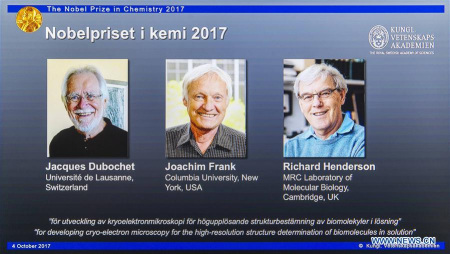
Winners of the 2017 Nobel Prize in Chemistry Jacques Dubochet, Joachim Frank and Richard Henderson (from L to R) are shown on a screen at the Royal Swedish Academy of Sciences in Stockholm, Sweden, on Oct. 4, 2017. Three scientists shared 2017 Nobel Prize in Chemistry, the Royal Swedish Academy of Sciences announced on Wednesday. The Nobel Prize in Chemistry 2017 was awarded to Jacques Dubochet, Joachim Frank and Richard Henderson "for developing cryo-electron microscopy for the high-resolution structure determination of biomolecules in solution". (Xinhua/Shi Tiansheng)
Three scientists have shared 2017 Nobel Prize in Chemistry, the Royal Swedish Academy of Sciences announced on Wednesday.
The Nobel Prize in Chemistry 2017 was awarded to Jacques Dubochet, Joachim Frank and Richard Henderson "for developing cryo-electron microscopy for the high-resolution structure determination of biomolecules in solution".
Dubochet, born 1942 in Aigle, Switzerland, is Honorary Professor of Biophysics at University of Lausanne, Switzerland; Frank, born 1940 in Siegen, Germany, is Professor of Biochemistry and Molecular Biophysics and of Biological Sciences at Columbia University, USA; Richard Henderson, born 1945 in Edinburgh, Scotland, is Programme Leader at MRC Laboratory of Molecular Biology, Cambridge, Britain.
In 1990, Henderson succeeded in using an electron microscope to generate a three-dimensional image of a protein at atomic resolution. This breakthrough proved the technology's potential.
Frank made the technology generally applicable. Between 1975 and 1986 he developed an image processing method in which the electron microscope's fuzzy two-dimensional images are analysed and merged to reveal a sharp three-dimensional structure.
Dubochet added water to electron microscopy. In the early 1980s, he succeeded in vitrifying water -- he cooled water so rapidly that it solidified in its liquid form around a biological sample, allowing the biomolecules to retain their natural shape even in a vacuum.
Researchers can now freeze biomolecules mid-movement and visualise processes they have never previously seen, which is decisive for both the basic understanding of life's chemistry and for the development of pharmaceuticals, according to a statement released by The Royal Swedish Academy of Sciences.
"The development of cryo-electron microscopy, which both simplifies and improves the imaging of biomolecules, has moved biochemistry into a new era," added the statement.
Explaining the scientific achievement, Peter Brzezinski, Member of the Nobel Committee for Chemistry, said that this year's scientific invention "enables us to see the molecules inside the cells and how they interact", and "in future, we are able to see the processes of how the molecules structures move."
Answering the question by Xinhua at the press conference on the inter-disciplinary researches in physics and chemistry for this year's invention, Brzezinski said this year's achievement is a "good example" of inter-disciplinary researches, in which, technologies play crucial roles to scientific discoveries.
Speaking through a telephone interview at the press conference, Frank said he was "never mind being woken up early" for the news of the Prize. "I was pretty overwhelmed. it's wonderful news."
This year's prize is 9 million SEK (1.1 million U.S. dollars), and will be shared by the three laureates.


















































